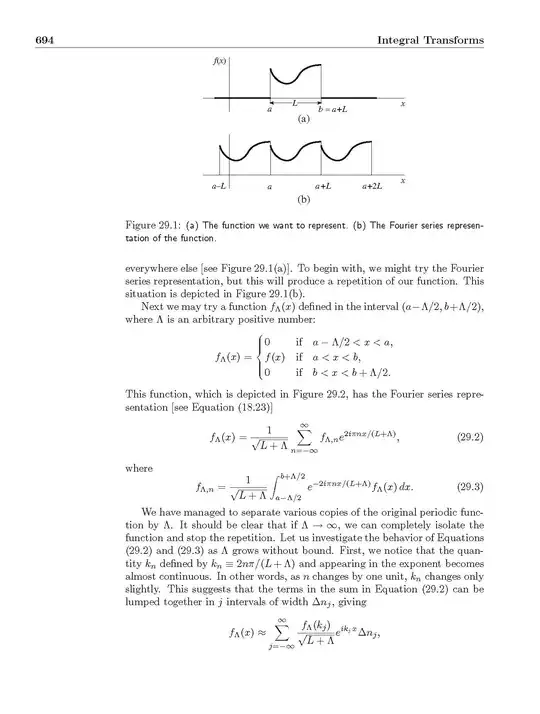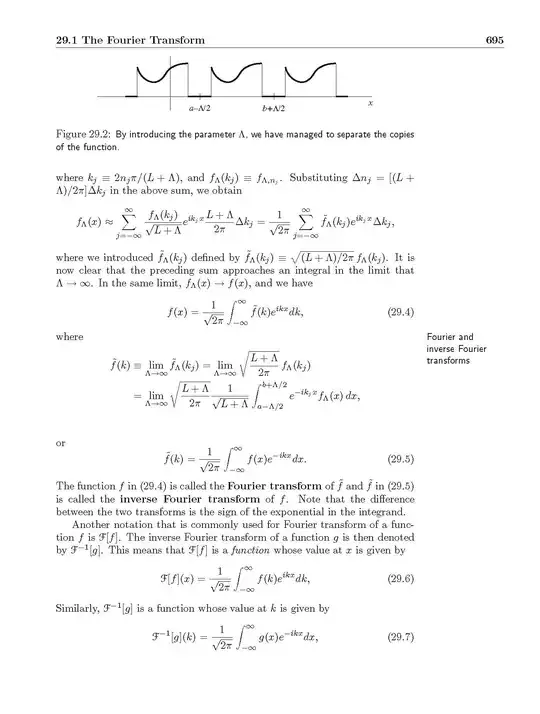I have a slightly different book that defines this differently. The motivation for the Fourier Transform can be seen from the following. This is from Richard Haberman - Applied Partial Differential Equations with Fourier Series and Boundary Problems
In solving boundary value problems on a finite interval $-L < x < L$
with periodic boundary conditions we can use the complex form of the
Fourier Series
$$ \frac{f(x+)+f(x-)}{2}= \sum_{n=-\infty}^{\infty} c_{n}e^{\frac{-in \pi x}{L}}$$
Where $f(x)$ represents a linear combination of all the sinusoids that are periodic with period $2L$ then we have the Fourier coefficients as
$$c_{n} = \frac{1}{2L}\int_{-L}^{L} f(x)e^{\frac{-in \pi x}{L}}dx $$
now then we have $ -L < x < L $ as our region of integration. So we extend it to $ - \infty < x< \infty $
$$ \frac{f(x+)+f(x-)}{2}= \sum_{n=-\infty}^{\infty} \left[ \frac{1}{2L}\int_{-L}^{L} f(\bar{x})e^{\frac{-in \pi \bar{x}}{L}}d\bar{x} \right]e^{\frac{-in \pi x}{L}}$$
For periodic functions $ -L < x < L $ the number of waves $ \omega $ in a distance of $ 2 \pi $ are then
$$ \omega = \frac{n \pi}{L} = 2\pi \frac{n}{2L}$$
giving us the distance between waves
$$ \Delta \omega = \frac{(n+1) \pi}{L} - \frac{n \pi}{L} = \frac{\pi}{L}$$

$$ \frac{f(x+)+f(x-)}{2}= \sum_{n=-\infty}^{\infty} \left[ \frac{\Delta \omega}{2\pi}\int_{-L}^{L} f(\bar{x})e^{i \omega \bar{x}}d\bar{x} \right]e^{-i \omega x}$$
Then the fourier transform here is as $ L \to \infty $. The values $ \omega $ are the square roots of the eigenvalues so they get closer and closer $ \Delta \omega \to 0$
$$ \frac{f(x+)+f(x-)}{2}= \frac{1}{2 \pi}\int_{-\infty}^{\infty} \left[ \int_{-\infty}^{\infty} f(\bar{x})e^{i \omega \bar{x}} \right]e^{-i \omega x} d\omega$$
Then the fourier transform is
$$F(\omega) = \frac{1}{2 \pi} \int_{-\infty}^{\infty} f(\bar{x}) e^{i \omega \bar{x}} d \bar{x} $$
The notation is that our interval $ - L < x < L$ has extended to infinity as you see. This is commonly what happens when you have some Riemann sum and take the discrete intervals and you let them go infinitly small.




